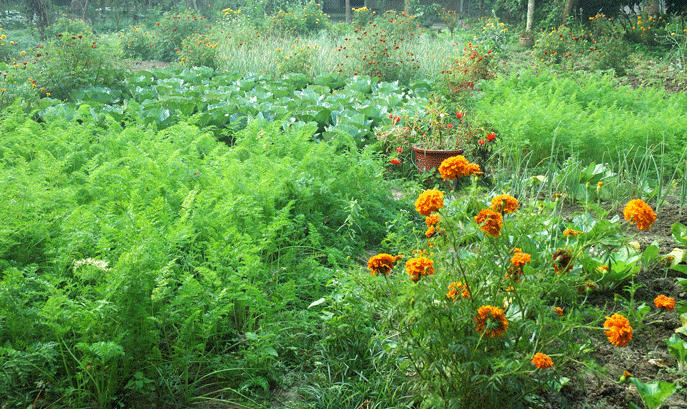
UBINIG
Biddaghors are the learning places with Nayakrishi as interactive points between UBINIG and the farmers and the people in the community. The Nayakrishi Andolon has spread in many parts of the country, from the south to the north, from east to the west. At present, UBINIG runs and manages the Nayakrishi centers in the districts of Tangail, Cox’s Bazar, Pabna, Kushtia, Chapainababganj, Kurigram and Sirajganj.
Each Biddaghor has residential facilities and meeting spaces as well as land space for selective research and experimentation. At the Biddaghor, Nayakrishi farming practices are done by the UBINIG members for their own learning. The Biddaghors also document various experiences gained by the farmers in their practice of ecological agriculture. It also maintains relations with other National Agricultural Research Centers (NARC), universities and academic institutions, NGOs and the government.
UBINIG does not believe in any “model” farm and rejects any concept of “centre” that assumes a self proclaimed responsibility to “train” farmers or disseminate “knowledge”. Nayakrishi centers are no more than a meeting ground of the community to facilitate collective interaction and learning. The centers also host a Community Seed Wealth center, linked to the activities of Nayakrishi Seed Network when it is convenient for the farmers of the adjacent villages.
The activities at the centres are very important. They provide practical experiences to share with the farmers. Also, the farmers can see directly what is happening at the centre, which raises their hopes and aspirations. The centres play a crucial role in the dissemination of information on various aspects of ecological farming and the environment. At the centers, group discussions, meetings and workshops are regularly conducted with the farmers and non-farmers, as a practice of general awareness building. Issues of food, natural resource management, biodiversity and farming practices belong to the general affairs of the community and not only to the farmers. The centers play, by its very existence as an integral part of village environment, very important cultural and educational roles for the community.
The government officials visit occasionally, officially and unofficially. Children are also very interested and eager to visit the centers. UBINIG has relations with village people through other projects such as weaving, children’s schools, health care and women’s development projects. People related to other NGOs are frequent visitors of the center and they are always keenly interested in the information generated on agriculture.
The center provides a unique place for women to gather and share knowledge amongst them. Besides general discussions of women’s issues they share knowledge on horticulture, seed preservation and food processing. Village women also possess knowledge and information on medicinal plants which, are shared between each other.
Centers are primarily built with local materials. As a general rule buildings or large constructions that insult the village life and are rejected. Centers are built with humble environment where farmers and the villagers can enter freely and be at home.
Each center usually has farmland. Research is carried out on different ways of farming, especially for learning for example, on how to make compost, crop diversification practices, mixed cropping practices, nursery building, and practical means of disseminating information on ecological agriculture.
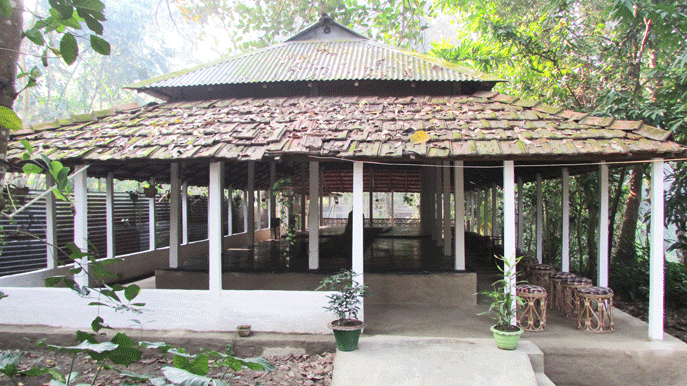
Ridoypur Biddaghor: TANGAIL
Ridoypur, the main centre of coordination of Nayakrishi activities, is located in Tangail, a flood plain north eastern district in Bangladesh. It is one of the agricultural surplus areas of Bangladesh and is well known for its handloom weaving. Apart from agriculture, weaving is also a predominant occupation of the people of Tangail.
Bishnupur-Nalshodha center provides space for training with accommodation for farm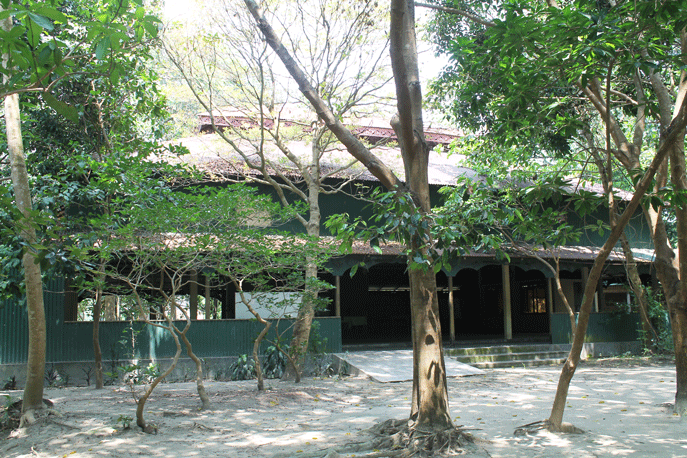 ers and NGOs working with the farmers, who come from different places of the country. This center has also a large venue, called the ‘Namghor’, for national, regional and international meetings, workshops and conferences.
ers and NGOs working with the farmers, who come from different places of the country. This center has also a large venue, called the ‘Namghor’, for national, regional and international meetings, workshops and conferences.
The center is well known for seed and genetic resource conservation and runs a large nursery and manages a well-developed Community Seed Wealth Center. It also has a very large collection of different varieties of jackfruit, grapefruit and other multipurpose trees.
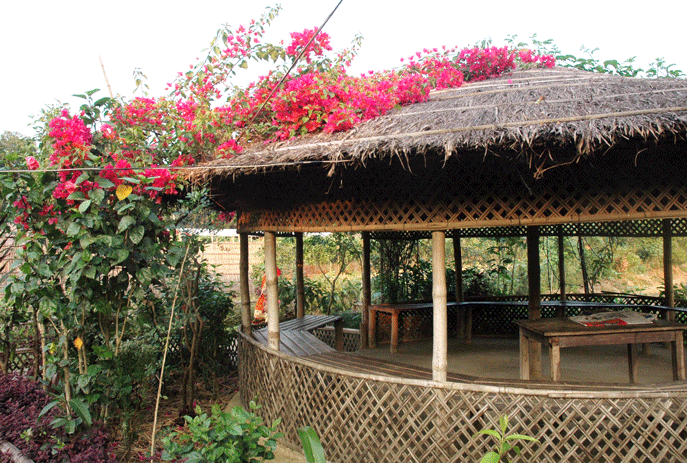 Paddaboti Biddaghor: COX’S BAZAR
Paddaboti Biddaghor: COX’S BAZAR
The Paddaboti biddaghor in Cox’sbazar district started in 1994 at Badarkhali Union under Chakaria Thana, a coastal sub-district in the south of Bangladesh. It is located at Mognamapara village on the bank of the river Matamuhuri. This center specializes in coastal ecosystems and marine ecology. It studies, with the Nayakrishi farmers, the innovative means of cultivating coastal lands where salt water often enters in the agricultural field and washes away due to the rain. It is a challenging environment for practising Nayakrishi.
The Nayakrishi farmers and the local community have regenerated nearly 10 kilometers of mangrove forest, previously destroyed by destructive shrimp cultivation. The integration of the forest as a part and parcel of Nayakrishi agricultural practice, is a new experience, and Nayakrishi farmers are pioneering many interesting pieces of research on the agricultural practice in these coastal areas.
This center also runs a school for the poor children of the area and runs women’s programs. 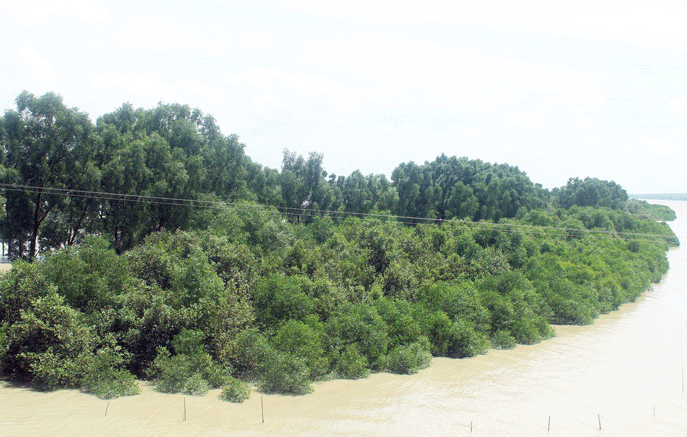 The area is also used for salt cultivation, but in the last decades, shrimp cultivation by the big companies has destroyed entire belts of the mangrove forests. Modern agriculture was introduced with excessive use of chemical fertilizers and pesticides. The success of Nayakrishi farming in regaining soil fertility and regenerating mangrove forests has attracted the attention of a large number of communities desperately struggling to survive in the coastal belts.
The area is also used for salt cultivation, but in the last decades, shrimp cultivation by the big companies has destroyed entire belts of the mangrove forests. Modern agriculture was introduced with excessive use of chemical fertilizers and pesticides. The success of Nayakrishi farming in regaining soil fertility and regenerating mangrove forests has attracted the attention of a large number of communities desperately struggling to survive in the coastal belts.
This center also plays key organizing role for both the marine and in-land fishing communities in order to defend their rights and interests as well as to protect aquatic diversity of coastal and marine ecosystems. The Bioddaghor has now shifted to Purbo Boro behula because of continuous floods and cyclones in the area.

Arshinagar Biddaghor: PABNA
The Arshinagar centre is located in Ishwardi Thana of Pabna district and covers North Bengal. The center had started in 1995. This district is one of the victims of excessive use of ‘Deep Tube Wells’, thereby suffering from the symptoms of salinity and desertification. Water is very scarce in this area. On the other hand, excessive pesticide use had been practiced for vegetable production resulting in severe consequences for the soil, environment and health.
The Northern districts of Bangladesh have distinct agricultural practices, and this center focuses particularly on the local ingenuity and researching ways and means to avoid disastrous consequences of the present agricultural practice. Nayakrishi is taking ground in this area, and the center is involved with the Nayakrishi farmers in collecting and conserving local and indigenous varieties of rice and locating the land races for future use and development. The center is also active in the collection of endangered germplasms of various types of mangoes.
particularly on the local ingenuity and researching ways and means to avoid disastrous consequences of the present agricultural practice. Nayakrishi is taking ground in this area, and the center is involved with the Nayakrishi farmers in collecting and conserving local and indigenous varieties of rice and locating the land races for future use and development. The center is also active in the collection of endangered germplasms of various types of mangoes.
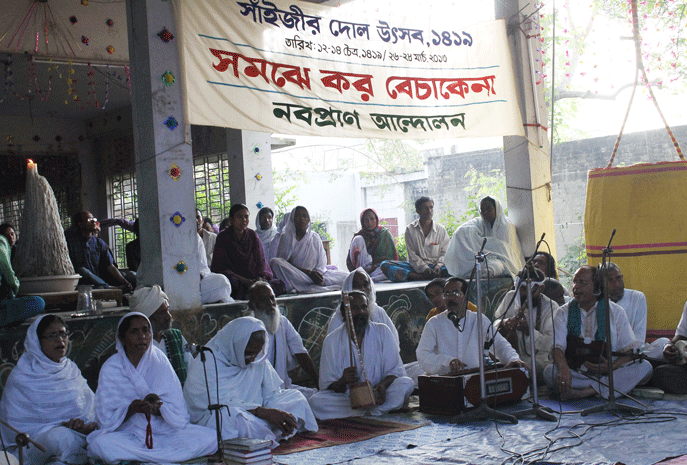 Nabapran Akhrabari: KUSHTIA
Nabapran Akhrabari: KUSHTIA
Nabapran Akhra is located in the Cheuriya village, adjacent to the famous shrine of Fakir Lalon Shah. This center is primarily used to network with the popular philosophers, singers, artists and people with strong spiritual values, who are strong allies of Nayakrishi Andolon. Every day, there are musical sessions in the morning and evening. The value of life is celebrated and thus the bridge is built with the Nayakrishi Andolon around the country with the poets and thinkers of the common masses. This is the main Akhra or center of the Nabapran Andolon, the cultural hub that maintains the network.
The Nayakrishi farmers come here regularly for meetings and to share their experience with others. This center was started in 1995.